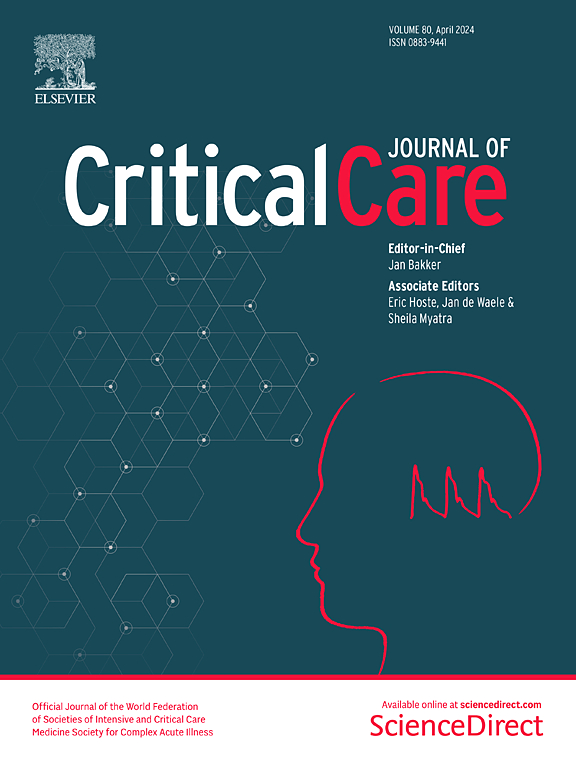First dose target attainment with extended infusion regimens of piperacillin and meropenem
IF 8.8
1区 医学
Q1 CRITICAL CARE MEDICINE
引用次数: 0
Abstract
Standard dosing regimens of meropenem and piperacillin-tazobactam frequently fail to achieve targeted plasma concentrations in critically ill patients. Extended or continuous regimens are often used to improve target attainment. Although prompt antibiotic initiation is a major determinant of survival, few studies have reported systemic concentrations early after treatment initiation. No prior study has reported concentrations immediately after the loading dose and first extended infusion. This study aimed to evaluate plasma target attainment during the first dosing interval with an extended infusion regimen in a general intensive care unit (ICU). Adult ICU patients were prospectively included in conjunction with the first administration of meropenem or piperacillin-tazobactam. Treatment was initiated with a 0.5 h loading dose immediately followed by a 3 h extended infusion; typically 4 + 4 g piperacillin or 1(− 2)g + 1(− 2)g meropenem, in line with the local ICU protocol. Patients requiring renal replacement therapy were excluded. Plasma concentrations were measured post-loading dose (Cmax), near the end of the first extended infusion, and at the end of the first dosing interval (Cmin). Samples were analyzed using validated tandem mass spectrometry (UHPLC-MS/MS) methods. The primary endpoint was the proportion of patients achieving 100% time above minimum inhibitory concentrations (fT > MIC) during the first dosing interval. This was evaluated using observed Cmin above 2 mg/L (meropenem) and 20 mg/L (piperacillin). Additionally, published pharmacokinetic models were applied to the observed data for %fT > MIC estimation, using an a posteriori Bayesian approach. We included 65 meropenem and 142 piperacillin measurements from 22 and 48 patients, respectively. Many patients (45% meropenem, 38% piperacillin) failed to reach 100% fT > MIC with the standard regimens used. Target non-attainment was associated with high estimated glomerular filtration rates (eGFR) and suspected augmented renal clearance (ARC). All meropenem patients that failed to reach target had eGFR > 90 mL/min/1.73 m2, as did 76% of corresponding piperacillin patients. Patients with suspected ARC frequently exhibited a tenfold or greater peak-to-trough decline (Cmin/Cmax < 0.1). Despite aggressive dosing, plasma concentrations often fail to reach 100% fT > MIC during the first dosing interval. Alternative regimens and early plasma concentration measurements followed by adaptive dose adjustments should be considered to improve target attainment.延长输注哌拉西林和美罗培南方案的首次剂量目标达到
在危重患者中,美罗培南和哌拉西林-他唑巴坦的标准给药方案经常不能达到目标血浆浓度。延长或持续的治疗方案通常用于提高目标的实现。虽然及时使用抗生素是生存的主要决定因素,但很少有研究报道在治疗开始后早期的全身浓度。之前没有研究报告在负荷剂量和第一次延长输注后立即浓度。本研究旨在评估在普通重症监护病房(ICU)延长输注方案的第一次给药间隔期间血浆目标达到情况。前瞻性地纳入了首次给予美罗培南或哌拉西林-他唑巴坦的成年ICU患者。治疗开始时立即给药0.5小时,然后延长输液3小时;通常为4 + 4g哌拉西林或1(−2)g + 1(−2)g美罗培南,符合当地ICU方案。需要肾脏替代治疗的患者被排除在外。分别在给药后(Cmax)、第一次延长输注接近结束时和第一次给药间隔结束时测量血浆浓度(Cmin)。采用经验证的串联质谱(UHPLC-MS/MS)方法对样品进行分析。主要终点是在第一次给药间隔内达到100%高于最低抑制浓度(fT > MIC)的患者比例。使用观察到的Cmin高于2mg /L(美罗培南)和20mg /L(哌拉西林)进行评估。此外,采用后验贝叶斯方法,将已发表的药代动力学模型应用于观察数据的%fT > MIC估计。我们分别纳入了22例和48例患者的65个美罗培南和142个哌拉西林测量值。许多患者(45%的美罗培南,38%的哌拉西林)在使用标准方案时未能达到100%的血氧饱和度。未达到目标与高肾小球滤过率(eGFR)和可疑的增强肾清除率(ARC)相关。所有未达到目标的美罗培南患者的eGFR均为0.90 mL/min/1.73 m2,相应的哌拉西林患者的eGFR为76%。疑似ARC的患者在首次给药期间经常表现出10倍或更大的峰谷下降(Cmin/Cmax MIC)。应考虑替代方案和早期血浆浓度测量,然后进行适应性剂量调整,以提高目标的实现。
本文章由计算机程序翻译,如有差异,请以英文原文为准。
求助全文
约1分钟内获得全文
求助全文
来源期刊

Critical Care
医学-危重病医学
CiteScore
20.60
自引率
3.30%
发文量
348
审稿时长
1.5 months
期刊介绍:
Critical Care is an esteemed international medical journal that undergoes a rigorous peer-review process to maintain its high quality standards. Its primary objective is to enhance the healthcare services offered to critically ill patients. To achieve this, the journal focuses on gathering, exchanging, disseminating, and endorsing evidence-based information that is highly relevant to intensivists. By doing so, Critical Care seeks to provide a thorough and inclusive examination of the intensive care field.
 求助内容:
求助内容: 应助结果提醒方式:
应助结果提醒方式:


